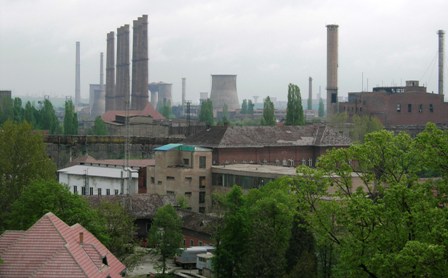Steeling ourselves in Romania
Romania left the impression of a country struggling to overcome the legacy of Soviet domination.20 23 Apr 08
.
We ended our track across Romania at the rust-belt town of Hunedoara in the west of Transylvania. We had come there to see Hunyad Castle, a medieval pile started in 1409 with major extensions about 1446, but stayed because there was a good hotel and it seemed like a nice enough little town.
.

.
Lunch in the carpark of Hunyad Castle, Hunedoara, Romania. Our little petrol stove gets plenty of work for these lunch stops.
.
After securing the Elephant and stowing our gear, we changed into our walking clothes and headed off to get some exercise and see the town. What we found was an interesting endnote to our Romanian journey that left us hopeful for the countrys future.
.

.
The inappropriately named Hotel Heaven was a nice enough stop in a neat and tidy town.
.
Under the planned Soviet economy, Hunedoara was turned into the second largest steel centre in Romania (or the entire Balkans) with the steel mills growing to equal the size of the town. The population grew to 86,000 in a well laid out town of ugly Soviet style apartments, wide streets and nice parks.
.
The industry was never efficient as raw materials were sourced from Australia, India and Canada, but these small details dont seem to bother central planners. With the collapse of the Soviet Union, however, traditional protected markets for Hunedoara steel disappeared. The mills were too inefficient and too dirty to compete on world markets and they closed without a whimper casting half of the population out of work.
.

.
The skyline tells the story! Dozens of stacks and no smoke. The steel mills covered a larger area than the town built to support them.
.
Things are still tough in Hunedoara, as they are in much of Romania. Jo noticed that there were a number of second hand clothing shops along the main street and a visit to the major super market found it well stocked but lacking a big line in luxury goods. Despite these indicators, we were surprised how well the town is surviving.
.

.
Renovations to the castle are part of efforts to broaden the towns income in tourism. There are several noteworthy sites in the district, but not enough to make it a tourism centre.
.
There has been some small reinvestment in the steel industry and several new factories have opened up to take advantage of cheap land and a skilled workforce. The population has dropped by about 10,000 leaving those who remain with a well appointed and comfortable town. Above all, the town retains the same clean and ship-shape look that we have seen all over Romania.
.

.
Arceler-Mittal have got one electric furnace and casting and rolling mills going but Hunedoara will never compete with other steel centres that have better access to raw materials and modern (clean) capital.
.
We started chatting about the town as we rode north towards the Hungarian frontier. It seemed to us that Hunedoara was a talisman for the whole of the country. It may have taken a bit of a beating over the last few years, but a strong community pride remains. With a bit of a run-up, they will be over the fence and away.
